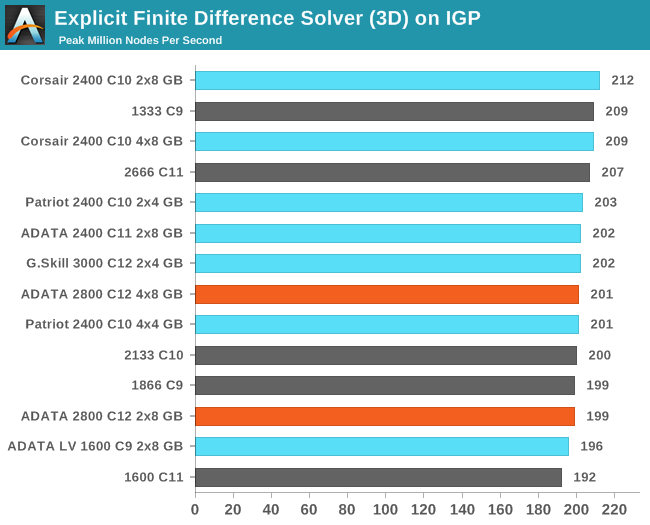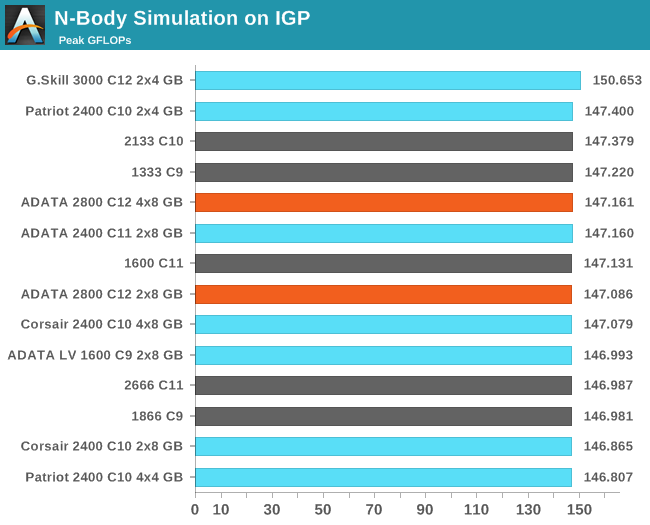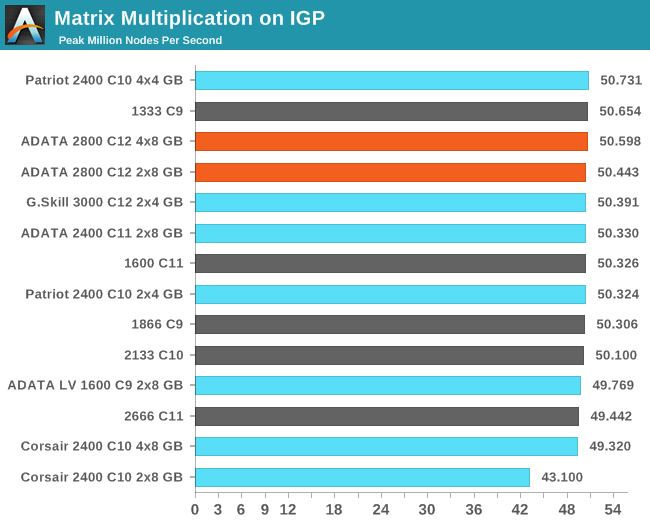ADATA XPG V2 Review: 2x8 GB at DDR3-2800 12-14-14 1.65 V
by Ian Cutress on December 17, 2013 12:00 PM ESTIGP Compute
One of the touted benefits of Haswell is the compute capability afforded by the IGP. For anyone using DirectCompute or C++ AMP, the compute units of the HD 4600 can be exploited as easily as any discrete GPU, although efficiency might come into question. Shown in some of the benchmarks below, it is faster for some of our computational software to run on the IGP than the CPU (particularly the highly multithreaded scenarios).
Grid Solvers - Explicit Finite Difference on IGP
As before, we test both 2D and 3D explicit finite difference simulations with 2n nodes in each dimension, using OpenMP as the threading operator in single precision. The grid is isotropic and the boundary conditions are sinks. We iterate through a series of grid sizes, and results are shown in terms of ‘million nodes per second’ where the peak value is given in the results – higher is better.


N-Body Simulation on IGP
As with the CPU compute, we run a simulation of 10240 particles of equal mass - the output for this code is in terms of GFLOPs, and the result recorded was the peak GFLOPs value.

3D Particle Movement on IGP
Similar to our CPU Compute algorithm, we calculate the random motion in 3D of free particles involving random number generation and trigonometric functions. For this application we take the fastest true-3D motion algorithm and test a variety of particle densities to find the peak movement speed. Results are given in ‘million particle movements calculated per second’, and a higher number is better.

Matrix Multiplication on IGP
Matrix Multiplication occurs in a number of mathematical models, and is typically designed to avoid memory accesses where possible and optimize for a number of reads and writes depending on the registers available to each thread or batch of dispatched threads. He we have a crude MatMul implementation, and iterate through a variety of matrix sizes to find the peak speed. Results are given in terms of ‘million nodes per second’ and a higher number is better.











19 Comments
View All Comments
YuLeven - Tuesday, December 17, 2013 - link
Thanks for the review.But with all due respect to this site that makes one of the best hardware coverage in English, I'm kind missing interesting stories lately. The late 2013 MacBook Pro, some Windows tablets, GPUs, CPUs, operate systems... anything.
As fat as real world performance is concerned, RAM impact is so negligible for the vast majority of users that this sort of article ends kinda of... boring.
Yet again, thank you for the article. I meant no offence in any way!
SeeManRun - Tuesday, December 17, 2013 - link
Definitely agree with this one...Zak - Tuesday, December 17, 2013 - link
I have to agree that these memory articles are uninteresting and not particularly useful. As others pointed out -- and these articles confirm -- the real life difference between decent DDR1600 and super-duper ultra-high-end RAM are virtually non-existent. One article summarizing that would be more than enough.jeffrey - Tuesday, December 17, 2013 - link
Ian Cutress,Hello again! This is another article stating 1866/C9 being the minimum for Haswell and to avoid 1600 or less. Even going so far as to say, "Any kit 1600 MHz or less is usually bad news."
However, this ignores 1600/C8 modules. The 1600/C8 score a 200 on your Performance Index at stock timings. This is at your recommended 200 level. There are several kits of 2x4 GB 1600/C8 on Newegg that have memory profiles of 8-8-8-24 at 1.5v. I'll repeat, these 1600 8-8-8-24 1.5v kits score 200 on the Performance Index and hit the current memory sweet spot for most people of 2x4 GB. This scores very close to the 1866/C9 kits which have a Performance Index score of 207.
The reason I bring this up is that the 1600 8-8-8-24 kits are often less expensive than the 1866/C9 kits and offer essentially all of the performance.
I enjoy reading your articles and appreciate how active you have been lately!
The_Assimilator - Tuesday, December 17, 2013 - link
This is why I am sticking with my DDR3-1600/CL7 memory until DDR4 hits mainstream. PI = 228 which is faster than 1866/CL9.jeffrey - Tuesday, December 17, 2013 - link
Ian, any comment on 1600/C7 or 1600/C8?Gigaplex - Tuesday, December 17, 2013 - link
"In this graph the x-axis is the Performance Index of the DRAM, and thus a PI of 200 can be 1600 C8 or 2400 C12."This article does not ignore 1600/C8 modules.
Popskalius - Sunday, February 23, 2014 - link
hi, i'm new to ddr3 lol. Re: haswell & 1600/C8, anandtech's intel gaming rig pairs an i5 with 1600/C9. Is this bc it's the cheapest build so not worth the price/performance, or is there really something bad about mixing haswell with anything slower than 1600/c8?thanks a bunch
Senti - Tuesday, December 17, 2013 - link
And another incompetent article from Ian... Didn't even bother to read comments to the previous one to correct errors...Oh, and my IP (range?) is still blacklisted by stupid spam filter. Of course, I probably not love my job enough...
AncientWisdom - Tuesday, December 17, 2013 - link
Lol maybe it should spam filter depending on the job happiness scale, seems legit.